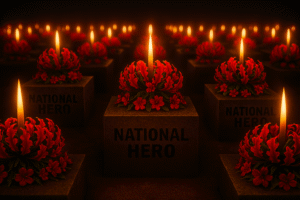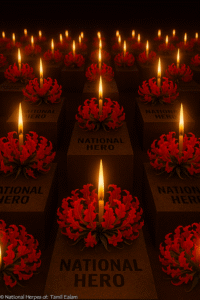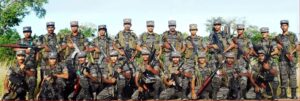Part I: The War of Fire Ignited in the Heart – Objective and Context

1.1 The Need for a Turning Point in the War
In the period when the Fourth Eelam War (2006-2009) was escalating, the Sri Lankan government planned extensive military operations in the North and East. The Anuradhapura Air Force Base (SLAF Anuradhapura) served as the main hub for launching attacks and coordinating supply lines to the Liberation Tigers of Tamil Eelam (LTTE) controlled areas. Strategically located on the Main Supply Route (MSR) from Colombo to the key LTTE stronghold of Vanni, it was a major military installation.
Destroying the military strength of this base became a critical necessity to counter the challenges posed by the LTTE’s air defence and ground forces. Attacking Anuradhapura, which was a powerful citadel for the Sinhala forces and a central base for combined Army and Air Force operations, was conceived as a strategic challenge that would decisively alter the military balance.
1.2 Ellalan: The Weight of the Name’s History
The naming of this operation as “Operation Ellalan” was not a mere military designation; it was an intense political-military declaration intended to etch the Tamils’ justice, historical rights, and valour onto the heart of the Sinhala nation. Naming the attack after King Ellalan (Elara), the Tamil monarch (Chola) who ruled Anuradhapura with justice in the 2nd Century BC—and was even praised by Sinhala Buddhist chronicles as the “Just King”—served to reinforce the Tamil Nation’s claim to sovereignty and established a deep footprint in a region considered the heartland of Sinhala dominion.
Part II: The Subtlety of Planning and the Black Tigers’ Devotion
2.1 The Leader’s Acute Strategy
The plan for this attack was formulated under the direct and highly intricate supervision of the Tamil National Leader, V. Pirapaharan. It diverged from the LTTE’s usual commando raids, structured as an Integrated Attack Strategy (Combined Arms Doctrine), coordinating ground infiltration with Air Tiger support.
● Intelligence Precision: Before the Black Tiger squad set out, meticulous intelligence was gathered on every aspect of the airbase: guard towers, hangars, fuel storage, pilots’ quarters, and security protocols.
● Ethos Given to the Fighters: A remarkable aspect of the final instruction given by Leader Pirapaharan to the 21 Black Tigers (including three female cadres) before their mission highlighted the high humanistic values embedded in the attack: “You must display your utmost valour. But should there be any children of officers present there, you must safely move them away and ensure no harm comes to them during the attack.” This instruction, given to a furious assault team aiming to destroy the enemy’s core base, underscores the moral dimension of the LTTE’s struggle.
● Psychological Readiness: To maintain the fighters’ stamina during the intense battle following a long-distance ground infiltration, the Leader’s reminder to carry “chocolates” (referred to as sokilettukkal in the original text) in their pockets, demonstrates the depth of care and connection between the leader and his combatants, even within the most rigorous military planning.
2.2 Ilango’s Vow and Arivumalar’s Compassion
The final words of the squad leader, Lt. Colonel Ilango, resonated with resolve: “We will fight carefully and patiently… We will show the Sinhala forces who the Liberation Tigers are.” This declaration ignited the fire of a great ideal in the hearts of the fighters.
The gentle nature of female fighters like Arivumalar in the squad helps us understand the humanity behind the ruthless combat spirit of the operation.
The historical necessity that compelled soft-hearted individuals like Arivumalar—who had once stood guard until baby rats were safely carried away by their mother during training—to muster the iron will to destroy the enemy, highlights the extreme oppression faced by the Tamil nation under the Sinhala military’s atrocities.
Part III: The Attack Trajectory and Military Challenge
3.1 Infiltration and Breach of Defences
22.10.2007, 3:00 AM: With the hum of beetles as their only witness in the floodlit perimeter of the base, the Black Tigers began their infiltration, using night vision equipment. The Anuradhapura base featured multiple layers of high-security fencing, razor wire, anti-personnel mines, and electrified barriers.
Black Tiger cadres Ezhilinpan and Pancheelan rapidly cut the fence, faster than they had practiced, creating a breach. Anbukkathir and Puratchy aimed their night vision-equipped weapons towards a nearby bunker, ready to neutralize any threat. Once the obstacle was cleared, the signal was given to Ilango, and the squads swiftly infiltrated the base.
3.2 The Integration of Air and Ground Tigers
Upon entering the base, the Black Tigers divided into two groups, led by Ilango and Veeman.
● Veeman’s Target: The group led by Veeman swiftly moved towards the main objective: the Mi-24 attack helicopters. In line with Ilango’s command, “We will destroy every helicopter and not let a single one take off,” they began destroying the aircraft.
● Ilango’s Target: Ilango’s team focused on destroying other crucial airframes, surveillance aircraft (especially the multi-million dollar Beechcraft surveillance plane), fuel storage facilities, and communication centres.
Minutes after the ground assault began, two light aircraft belonging to the Air Tigers arrived from Vanni, bombed the airbase, inflicting further damage to aircraft and infrastructure, and successfully returned to their base. This combined ground-air operation marked a rare and significant achievement in global military history for a non-state actor.
During the fighting, a Sri Lanka Air Force Bell 212 helicopter, dispatched to assist the base, was reportedly shot down by friendly fire, killing its four crew members. This incident underscored the state of confusion and the intensity of the attack that had overwhelmed the Sri Lankan military command.
Part IV: Military Significance and Global Impact
4.1 Military and Political Ramifications
“Operation Ellalan” was not just a military attack; it delivered profound political and psychological consequences:
● Demonstration of Warfighting Capability: The successful infiltration and destruction of the heavily fortified base by just 21 Black Tigers underscored the peak of the LTTE’s intelligence, training, and self-sacrificial dedication.
● Major Air Force Loss: The destruction of over eight crucial aircraft, including the high-value surveillance plane, caused a significant setback to the Sri Lankan government’s air superiority and elevated the LTTE’s intelligence capabilities in the eyes of the world.
● Global Recognition: International military analysts described the attack as an “unbelievably determined, brave, and precise commando raid” that no other “terrorist organization” in the world could have executed. The operation firmly re-established the LTTE as a formidable military force.
4.2 The Eternal Flame of Operation Ellalan
In fulfilling their Leader’s wish that they become an indelible part of history, Ilango, Veeman, Arivumalar, and the 21 Black Tigers achieved their supreme goal, carrying the national flag into the heart of the enemy’s citadel. They sowed fear within the Sinhala domain and brought pride to the Tamil Nation.
Today, this operation stands as a turning point in the history of the Tamil National Liberation struggle and an enduring symbol of unparalleled sacrifice. “Operation Ellalan” is more than a successful battle; it is an epic that carried the unquenchable fire of liberation, igniting a war of fire in the heart of the enemy.
──────────


──────────
Written by Eelaththu Nilavan
Tamil National Historian | Global Political, Economic,Intelligence & Military Analyst
───────────────────────



